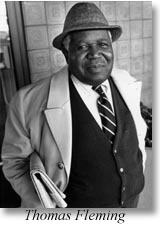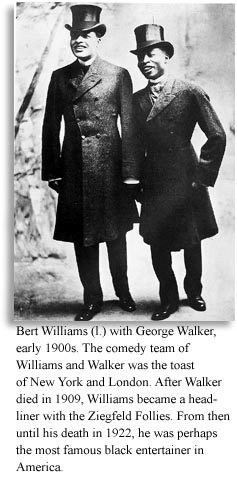

Hear the Mills Bros.' 1932
Reflections on Black History
By Thomas C. Fleming
CBS Promo Recording (RealAudio)
San Francisco History
Index
History by Subject
History by Year
Biographies
The Museum's Homepage
REFLECTIONS ON BLACK HISTORY
Column 2: Black Entertainers on Vaudeville
By Thomas C. Fleming
Jacksonville, Florida was a big city when I was living there before World War One, and a lot of vaudeville came in there. Vaudeville was wonderful. They would always have both a motion picture and stage acts. It usually started in the early afternoon. A screen would come down over the stage for the movie, and would be raised when it was over. They would take turns showing the movie and presenting the entertainers until late at night. Most times the vaudeville show was a little longer than the motion picture.
For the stage acts, there generally would be a comedian, a dancer and a vocalist, all of them well known. Most of the larger theaters had a house band – a pit orchestra. They lived in that town, and they were hired to accompany whatever entertainer was on the stage. When they knew the entertainer was coming, they would have the musical arrangements all ready, so they could practice together before the show.
There weren't many whites living in the part of Jacksonville where I grew up, and few whites showed up in those theaters where I went. I heard that if blacks went to theaters outside of the black areas, they could sit only in the balcony. We referred to that as the crow's roost. This was also true in other parts of the United States, including the Midwest and California.
 Around 1915, Bert Williams, the comedian, came to Jacksonville with a vaudeville
show, and I went to see him.
Around 1915, Bert Williams, the comedian, came to Jacksonville with a vaudeville
show, and I went to see him.
There were a lot of black entertainers, but he had the biggest name. He went up higher than any before him. He was the first black to become a star in the Ziegfeld Follies, an annual revue on Broadway in New York. That's when he was really on the big time. Year after year, when Flo Ziegfeld produced each new show, Bert Williams was one of the headliners.
I'd heard his name a lot, even at that age. The talk in black communties all over the United States was that he had a diamond installed in his upper teeth. It flashed every time he opened his mouth, singing or talking.
He dressed in a battered silk hat, with a tailcoat and trousers too short, and ridiculous oversized shoes that slapped the floor very hard when he walked. That was his regular costume. Then he blacked his face too. A lot of black comics then put blackface on, like the whites used to when they were in the minstrel shows.
He would come out there and talk all his ridiculous talk. Then Williams sang too, in his style. It was supposed to be singing, but it was more like a dialogue, done in a singsong way and very earthy. He sang about bad luck and being without very much money. He used to record comic songs for Columbia Records. I bought some of his records years later, when I got a Victrola. He had one where he said: "You ask me what I need. Well, I needs everything from my hat down to my overcoat in."
I saw him just that once, but I remember him so well because I was watching that diamond all the time I was there.
Williams and some other black comedians were offered contracts by the Orpheum Circuit. That was the biggest vaudeville chain; they went all over the United States. Then there were smaller chains, like the Theatre Owners and Bookers Association, which they called TOBA. It was mostly in the Deep South. It had only black entertainers, and played to black audiences.
The TOBA theaters were owned by enterprising whites who saw an opportunity to put a theater in black neighborhoods, where the biggest names in Black America would appear.
In Chicago, it would be on State Street or Michigan Avenue, the main streets for
blacks. In New York City it was Lenox Avenue. In Philadelphia it was Pearl
Street. There were also TOBA houses in Baltimore, Washington, DC, St. Louis,
Kansas City, and I believe Memphis. The world-
When Duke Ellington and others came along in the '20s and early '30s, they
started appearing in those theaters also, aside from playing in nightclubs. One
could see all of the big names – Pigmeat Markham, Ma Rainey, Billie Holiday in
her early days, Ella Fitzgerald, Bill "Bojangles" Robinson, Fats Waller, and
such bands as Jimmy Lunceford, Cab Calloway, Chick Webb, the Mills Brothers when
they first started, and just about any other black entertainer who appeared
before the public then.
At the age of 8, I left Jacksonville as a stowaway on a coastal steamer and
arrived in New York City, where I spent the next three years.
©1997 by Thomas C. Fleming. Born in 1907, Fleming is a writer for
the Sun-
Return to the top of the page.
